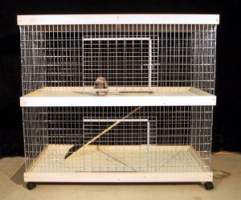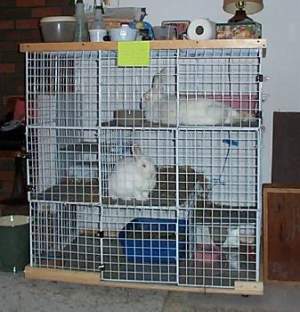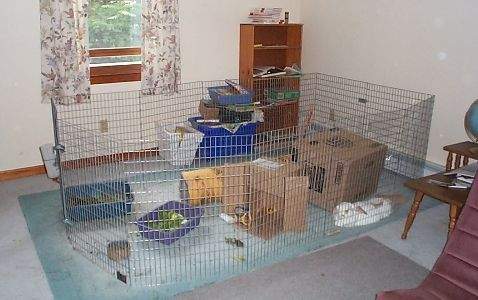Rabbit Real Estate: Housing Options for Your Pet Rabbit
House rabbits can thrive in a variety of indoor setups: some enjoy expansive estates consisting of their owners’ entire living space, others have luxury high-rise condos or studio apartments with adjoining playgrounds. There are some basic requirements for all habitats; once you have that covered, there are lots of enclosure options that allow you to work with the space you have and your rabbit’s character to develop a habitat that you both enjoy.
The Basics:
Cages must have a smooth floor to prevent injury or wear to furry feet, a door wide enough to allow a large litterbox, and be at least six times the size of your rabbit with sufficient height to accommodate your rabbit being able to stand up on their hind legs. The more time you plan to have the bun stay inside, the bigger the cage should be. We recommend as much “out” time as possible and regular play and interaction with you every day for the rabbit’s health and happiness. Play areas must be bun-proofed: safe from electrical cords, houseplants, and other hazards to the rabbit and with possessions you’d like to keep intact out of reach. Oh, and don’t forget plenty of bun-safe toys.

Some Options:
Cages range from the basic to the exotic, and many people make their own. Many of the rabbit cages sold in pet stores are far too small and have wire floors. Consider instead a dog crate for a basic cage instead: the ones made by Precision for larger dog breeds work well, are foldable, rust-proof, easy to clean and sturdy. Best for “headquarters” and overnight, these are best when combined with a play pen or extensive free time because they’re not very big. Other cage models have top-opening options that can help if your rabbit resists being lifted through a side entrance. If you do end up with a traditional wire rabbit cage, you should cover the floor with either brownboard, cardboard, or carpet if your rabbit does not chew.
Many apartment dwellers and fosterers use high-rise condos. There have been several variations on this popular theme, and you can order different widths and one, two or three levels depending on your needs. Rabbits love going up and down the ramps and having more of a view. Condos can be ordered on line from Leith Petwerks. Ramps and upper floors need low-pile carpet or other texture for sufficient traction. The condos are expensive, but well worth the money. Older versions of these condos are Rabbitats and Jester Condos.


If you are creative, another condo option is the Neat Idea Cube Condos. They are made from wire panels assembled to the needs of your rabbit. Not only can you customize your rabbit’s home, it is less expensive. They aren’t that difficult and many people have assembled them within a day. They vary in height, have different shelf arrangments and flooring options. For constructing your own cage, see our article on Neat Idea Cube Condos!


Puppy play yards—a series of metal fencing panels connected by hinges–can be used in addition to a cage or as a substitute. These allow the bun to have more space while still keeping her confined to a safe area while you’re not around to supervise.

If you are going to set up a pen and leave it in place, I like the heavier gauge brands such as Midwest or Precision because they are more stable, and you can get these at the warehouse style pet stores or on line. The lighter weight pens by KWCages are usually prefered by people that will be moving the pen around and want a more portable option. The exercise pens are very versatile, allowing you to shape a circle (link two together for a more active bun), divide a room in half for two rabbits to share, or set up a rabbit corner. When bun’s out, the pen can be used to protect a zone you want to keep off limits, like your computer desk. If your bun isn’t completely box trained, you can set up the playpen with a shower curtain liner covered with a sheet or cotton throw rug. If it’s a permanent or semi-permanent setup, some people buy sheets of linoleum or vinyl to place under the area to preserve wood floor or carpet. Add a big cardboard box or pet carrier for napping and some toys and your bun will have it made.
CAUTION: rabbits may jump over play fences so make sure to get a model that’s high enough. Ironically, smaller breeds are often lighter and can jump higher than bigger, heavier breeds. The fences come in a variety of heights, so err on the side of higher and watch bun carefully to make sure he stays inside before leaving him alone. They can also climb on boxes to get out, so keep those away from the edges!
Finally, the free run option. Most altered rabbits become neat enough with their litterbox to be out loose all day with a designated bathroom corner. This is where bun proofing and your observations are very important—if you want a free run bun, see what he likes to chew—handbags, books, shoes, fabric, wood? Your bun may shred everything in sight so don’t worry if free run isn’t an option, it’s not always safe. Chew deterrents like Bitter Apple can help preserve small problem areas. Remember that some buns climb onto chairs, sofas and tables and can snack on fruit and plants you thought were safe. Free run is very rewarding for you and your rabbit but if this is your goal, work up to it one room at a time to make sure you can accomplish this safely. The kitchen’s often a good place to start as it’s often the center of activity, and relatively easy to bun-proof. A play pen can be used to protect high-risk zones too.
Every rabbit/owner/home combination is unique. You want a living space for your bun that gives you easy access for sitting down next to him for pets, watching him zoom around or do his special snack dance, take power naps, etc. Also consider your rabbit’s perspective, is she an outgoing rabbit who wants to check everything out and be in the thick of things or shy bun who needs a peaceful retreat to feel secure, for example. Rabbits enjoy watching and listening to our daily routines, so the more time we can spend together, the better!
by Suzanne Rubins & Suzanne Trayhan
